Brief
Will Amazon Steal Christmas?
Will Amazon Steal Christmas?
We examine where and how the online juggernaut is investing this season, and what that means for the rest of the retail landscape.
- Min. Lesezeit
- Summarize with Generative AI
Brief
We examine where and how the online juggernaut is investing this season, and what that means for the rest of the retail landscape.
The holiday shopping season is now officially under way, and Amazon.com is busy filling stockings. The online juggernaut continues to expand its offerings—notably in apparel, groceries and Amazon-branded electronics—while maintaining aggressive pricing on best sellers and resetting shoppers’ expectations in terms of service and shipping speed.
In this issue we dig beneath the headlines and examine where and how Amazon is investing this season … and whether Seattle is becoming the new North Pole.
Recent data from the US Census Bureau bolsters our view that holiday sales will grow at approximately the same rate as last year, between 3.5% and 3.9%. According to a survey from the National Retail Foundation taken before the US election, more than 25% of shoppers said the contest would affect their holiday spending. This seems to be reflected in preliminary data for October showing that sales grew by about 2.5% year-over-year. However, retail executives have confirmed our view that shoppers are poised to open their wallets again now that the election is over. We’ll keep track of how this translates to sales at the register.
One company is continuing to deliver breakneck growth: Amazon. Its third-quarter earnings announcement showcased a year-over-year revenue increase of 26% in its North American retail business. Estimates for growth of gross merchandise value in the region—the total sales value of merchandise sold through Amazon, including items sold by third-party sellers via the Amazon Marketplace—tally even higher, between 30% and 35%. Although the company disappointed investors with lower-than-expected earnings, Amazon clearly signaled to its competitors that it remains willing to sacrifice margins for market share.
We estimate that US e-commerce sales will reach approximately $390 billion this year, and that Amazon’s share, including its Marketplace sales, will be close to 35%. Our analysis further suggests that by 2018, US e-commerce sales will grow to nearly $500 billion and that Amazon’s share will increase to almost 50%—a 30% compound annual growth rate.
Amazon’s rapid growth is being fueled in part by the expansion of Amazon Prime. Several sources estimate that there are currently upward of 60 million Prime members in the US, and that number is likely to grow this holiday season. In 2015 Amazon added more than 3 million new Prime members in the third week of December alone. This year Amazon is promoting the debut of its original series, The Grand Tour, with a one-day Prime membership promotion. On November 18, new members will be eligible for 20% off the first year’s annual fee.
For customers, Prime is not just about fast and free shipping; membership offers a large and growing number of benefits (see Exhibit 1). For Amazon, Prime builds loyalty. Prime customers spend an estimated $1,200 per year—more than twice as much as their non-Prime counterparts.
What is the formula behind Amazon’s growth? The company continues to invest in its “flywheel,” the three accelerators that sustain its success:
This formula—and the impressive revenue growth it has enabled—has fueled Amazon’s industry-leading total shareholder return (TSR) of 31% over the past five years. In our analysis, we decomposed the elements that contribute to TSR and then calculated percentages to indicate how much each element contributes. Higher percentages reflect a larger contribution, and negative percentages reduce cumulative returns. The company’s TSR has gone up even more over the last year, in part due to high margins from the Amazon Web Services business (see Figure 1).
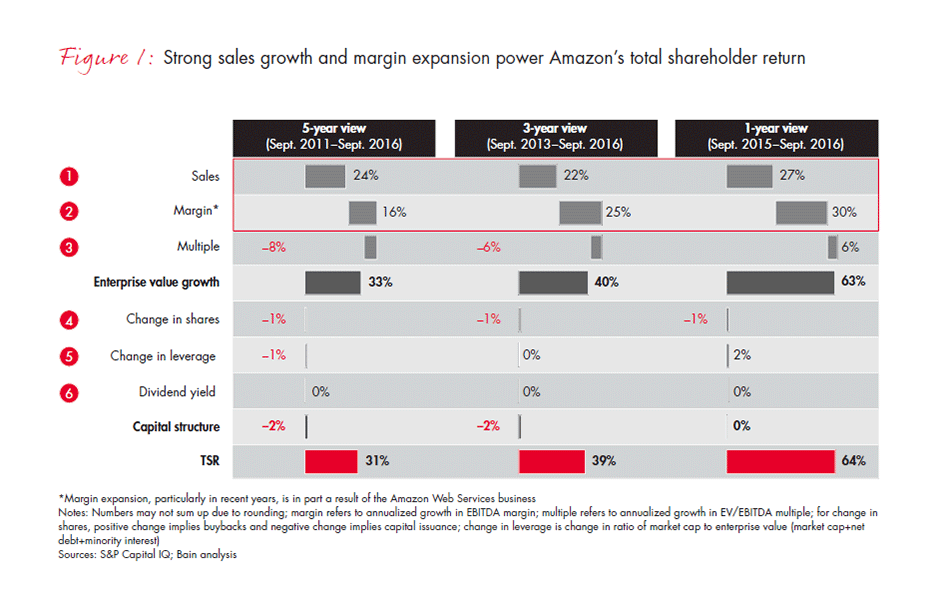
Moreover, in comparison with its peers, Amazon’s TSR is one of the highest across multiple time periods (see Figure 2).
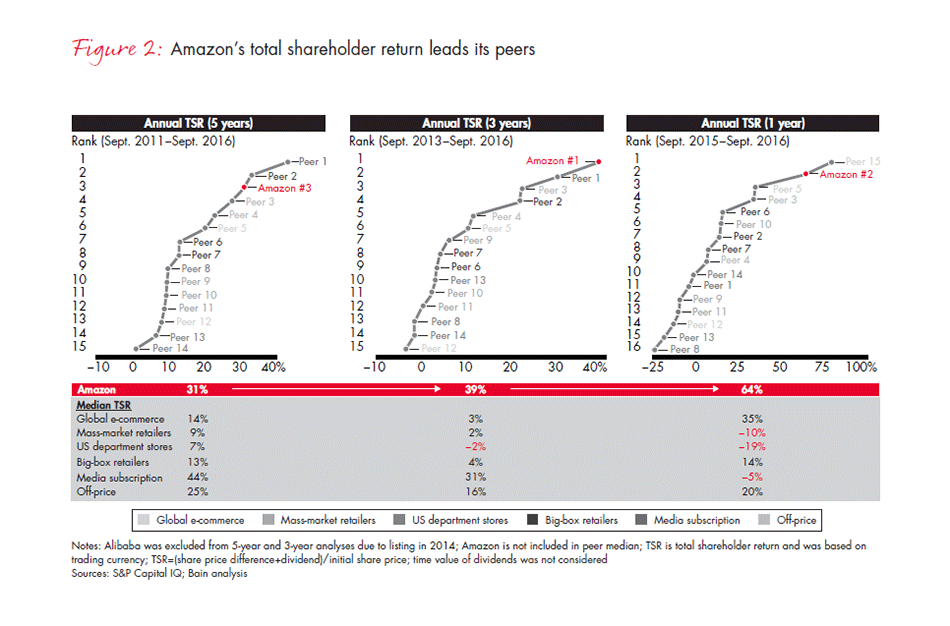
What’s in store this holiday season? All signs point to Amazon continuing to invest in its flywheel strategy across all fronts.
Assortment: All eyes on apparel, groceries and Amazon-branded electronics
From Santa hats to Christmas hams to virtual personal assistants, Amazon wants to sell it all—in ever greater quantities—this holiday season. Books and consumer electronics remain leading categories; but apparel, groceries and Amazon-branded consumer electronics look to be this year’s headline grabbers.
Apparel: Everything to fill your closet. There has been lots of discussion about Amazon’s increasing sales of clothing products. Although it’s hard to confirm published totals of the online giant’s apparel sales, Bain’s analysis confirms Amazon has become a significant force in the sector, particularly if we include footwear and Zappos.com. In partnership with 360pi, we’ve seen a year-over-year doubling of items listed in the clothing, shoes and jewelry category to approximately 33 million items (see Figure 3). The vast majority of this merchandise is listed on the Amazon Marketplace, meaning it’s sold by third-party vendors through Amazon’s site. But the number of Amazon-sold products also has doubled. Among those products are more than 1,300 private-label items across multiple brands for men, women and children.
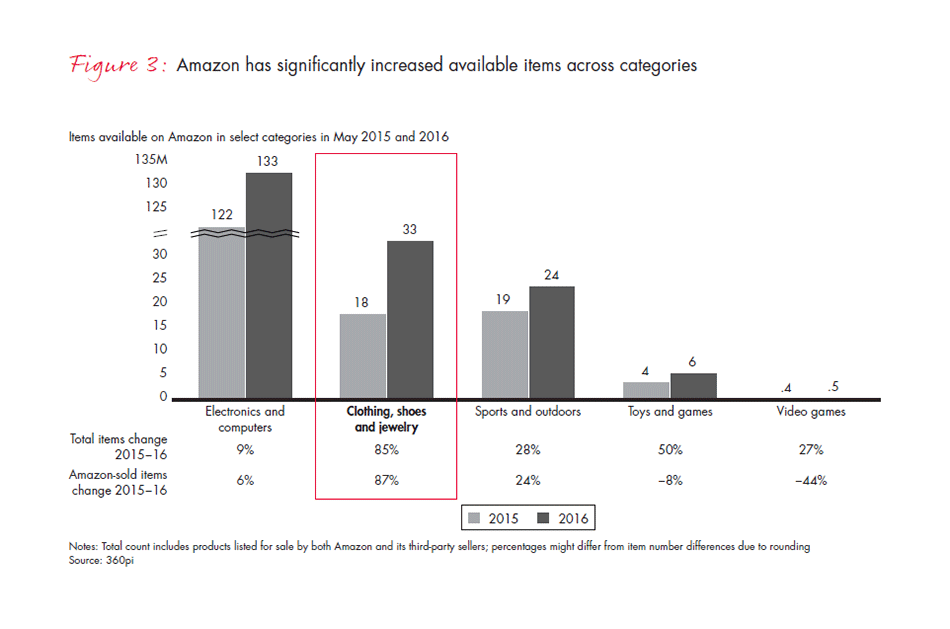
What kind of clothing is Amazon selling in large quantities? The company’s year-round best sellers—items that were on the best-seller list for more than 70% of the year—are largely basic items like men’s jeans and sneakers from familiar brands like Levi’s, ASICS and Skechers.
Third-party sellers are an important contributor to the breadth of Amazon’s assortment. Yet the profitability of the Amazon Marketplace differs depending on whether or not third-party sellers participate in the Fulfillment by Amazon program. Bain estimates the company makes less on FBA sales than it does on third-party sales fulfilled by the sellers—even after increasing FBA fees this holiday season. Still, Amazon’s FBA program allows it to offer Prime customers free two-day shipping on a broader variety of goods, which in turn makes Prime membership more attractive.
Groceries: Everything to fill your fridge, freezer and cupboards. Amazon is expanding its grocery offerings, and, in many markets, Amazon’s website is a source for everything shoppers need to plan, cook, host and clean up after holiday feasts.
In addition to shelf-stable groceries—long an Amazon offering—this holiday more shoppers than ever are able to buy fresh and frozen foods through AmazonFresh, the company’s fresh-food service. This year the service expanded to Boston, Baltimore, Chicago, Dallas and London. The company also has increased its coverage in existing markets. For example, New York service now reaches parts of Connecticut.
We analyzed demographic characteristics of the US metropolitan areas where AmazonFresh is available and found that those areas are wealthier than average and that the specific zip codes AmazonFresh serves are more densely populated than those metropolitan areas as a whole. If Amazon continues with its current model, we project it will reach about 18 million households—approximately 15% to 20% of US households. However, given Amazon’s history of rapid innovation, the model could change. Rumor has it that the company will open 20 small-format physical grocery stores by the end of 2018 and as many as 2,000 by 2025.
Technology: Making ordering gifts as easy as saying, “Hey, Alexa.” Amazon is aggressively promoting its “device family” this holiday season, particularly the Echo, Echo Dot, and Tap, all of which feature the Alexa personal assistant. These products are marketed as smart-home devices and Bluetooth speakers, and they’re sold at Amazon and other retailers. Alexa can play music, tell you the weather, connect to other devices and much more. It’s also designed to make ordering from Amazon effortless. Estimates are that more than 1 million Alexa-enabled devices have been sold, and their owners are reported to have increased their spending on Amazon by 10%. Amazon is also offering “Alexa-exclusive deals” through a variety of promotions.
Despite an initial stumble or two, last year’s ordering innovation, the Dash Button, continues to expand in scope. The Wall Street Journal reported this summer that the Dash Buttons were not doing well with customers, but Amazon announced in October that it was adding more than 60 brands to the program—bringing the total above 200—and that orders were up more than 500% over the past year.
Ringing in the season with low prices … on best sellers
The second element in the Amazon flywheel is price, and consumers continue to give the retailer credit for good prices. According to Bain’s Shopping Experience Pulse, a survey in collaboration with Research Now, nearly 75% of consumers who shopped at Amazon said that the company offers good prices. This sentiment was validated by our finding that 50% of online shoppers checked Amazon before buying elsewhere, as did more than 30% of those who shopped in stores.
The skinny on pricing. Are Amazon’s prices really the lowest? On best sellers, often yes. On everything else, not always. In October Bain partnered with 360pi to compare the online retailer’s prices with competitors’ prices across four product categories. On its best-selling items, Amazon had the lowest price around 70% of the time across categories and was tied for the lowest price approximately 20% of the time. For example, Bain comparison-shopped eight best-selling styles of Levi’s jeans across five retailers, including Amazon, and found that Amazon was offering lower prices than the competition by more than 10% on average.
However, looking at all the products in the categories we studied, Amazon had the lowest price only between 20% and 30% of the time and was tied for the lowest price between 40% and 50% of the time—a noticeable difference from its pricing strategy for best sellers (see Figure 4).
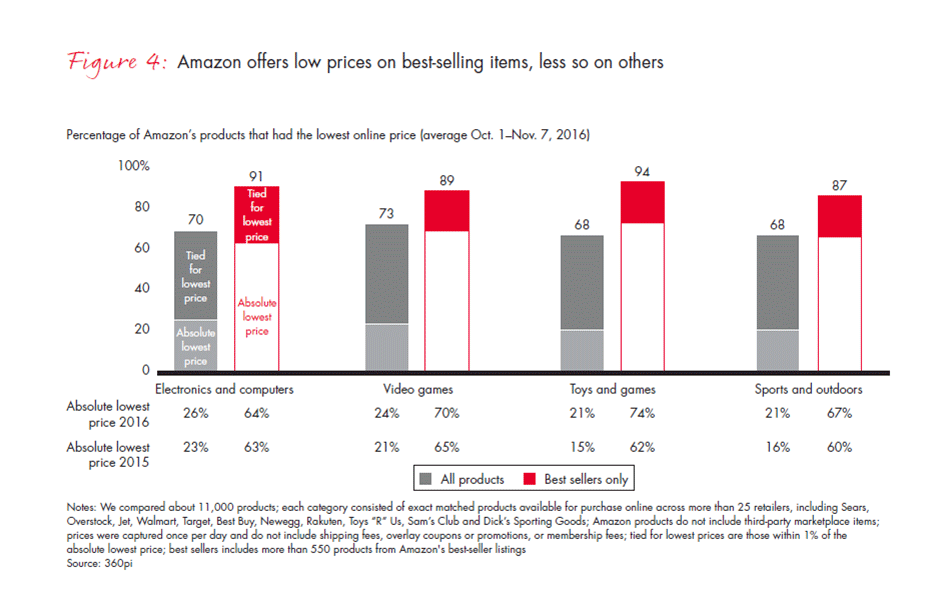
Another revelation: Amazon’s customers are not always steered to the lowest-priced item on the site. The company’s algorithm favors items sold by Amazon and FBA sellers by not including shipping charges as part of the total cost. These items are assigned a higher rank in the “buy box” on the basis of price than they should be around 80% of the time. (The buy box is where customers can compare what different sellers are charging for the same item. In addition to price, it ranks based on availability, customer service and other factors.) Although this bias doesn’t impact Amazon Prime members or customers who purchase enough items to earn free shipping, other shoppers may be paying more than they could.
Frequent price changes. Amazon also changes its prices more often than the competition. What’s a good deal now may not be such a good deal in a day or even an hour. Or it could get even better. Bain and 360pi monitored the prices of a basket of goods across four major categories and found that Amazon changes its prices up to three times more often than do any of its competitors individually (see Figure 5).
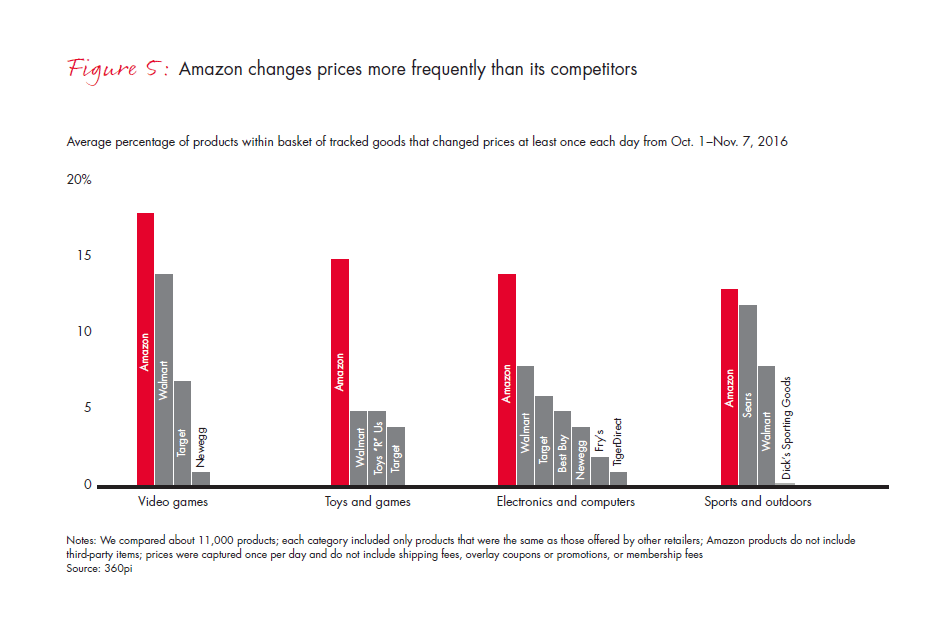
Keeping customers happy
Experience: Upping customer satisfaction. Delighting customers during the holidays pays high returns in sales and loyalty, and Amazon seems to know exactly how to do that. Bain’s Shopping Experience Pulse shows that as of early November, Amazon customers had a considerably higher Net Promoter Score® (NPS®),1 a measure of customer advocacy and satisfaction, than did customers of other retailers: 54 compared with 40 for customers who bought from a physical store’s website and 36 for customers who bought in a store (see Figure 6). And our survey suggests that Prime members have an even better experience than regular Amazon shoppers, with an NPS of 60 vs. 41.
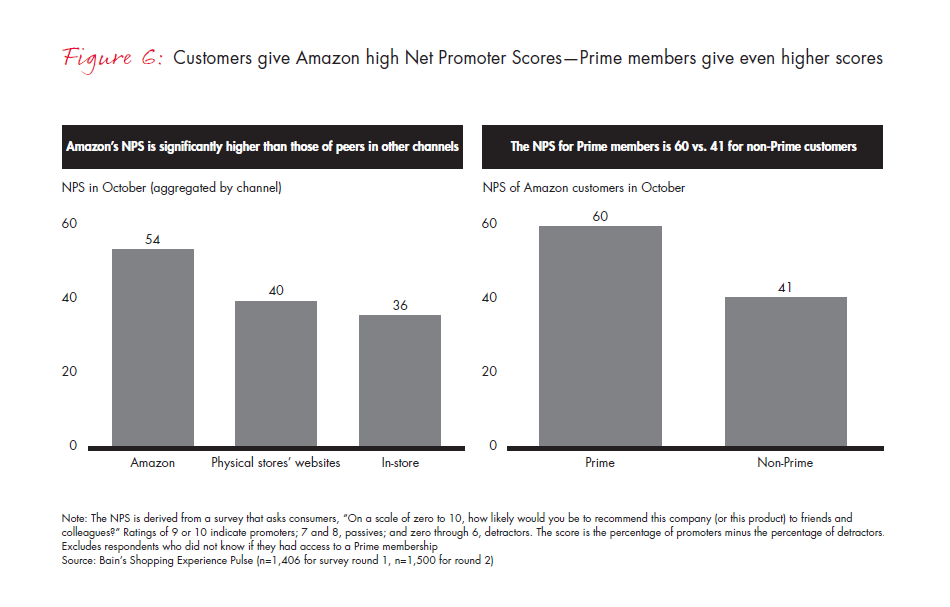
Distribution: Delivering a great holiday experience. Amazon continues to set the gold standard in customer experience, particularly for fast delivery, and it has expanded its capacity significantly this holiday season. The company is on track to add 26 fulfi llment centers this year, which will grow its total square footage by 30%, well above the 20% growth seen in 2015. To free up warehouse capacity, it has increased its storage fees for third-party sellers, encouraging those sellers to delay shipments of nonholiday goods. And it’s increasing seasonal hiring by 20% over last year, to 120,000 workers, while many of Amazon’s competitors are hiring roughly the same number of seasonal workers they did last year.
Amazon’s distribution network is estimated to have a fulfillment node within 20 miles of nearly 50% of the US population, a total of almost 200 domestic facilities ranging from fulfillment centers to Prime Now hubs. (Prime Now is the company’s one- to two-hour delivery service.) Yet the company is making additional investments to gain control over its operations, bringing the online retailer into competition with its logistics partners UPS, the US Postal Service and FedEx:
We believe that Amazon will keep up its breakneck pace of innovation in logistics. We also believe that it will continue to change the expectations of all online shoppers.
No question, Amazon is a formidable competitor. But that doesn’t mean Amazon will steal Christmas. Here are some ways for retailers to make their own holiday magic:
We love consumer data and wanted to better understand how people are feeling about shopping this holiday season. Will the customer experience deteriorate as lines get longer and shelves go bare? Or will retailers delight customers with unique and inspiring products and a seamless shopping experience? For answers, we launched Bain’s Shopping Experience Pulse to track shoppers’ behaviors and feelings.
We surveyed 1,500 consumers across the country twice in October in partnership with Research Now, asking about their most recent shopping experience. We wanted to know everything from would they recommend a particular retailer to a friend based on their recent experience, to whether they were excited about shopping for the holidays. Here are a few of our key findings:
We will continue measuring shoppers’ satisfaction and sentiment throughout the holiday season with a new Pulse every other week. Stay tuned for additional insights in upcoming newsletters.
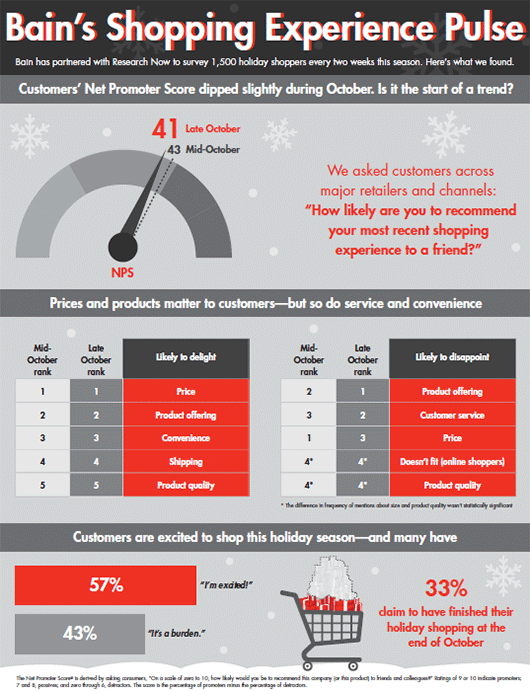
We wish you all success over the upcoming Thanksgiving shopping weekend. We’ll be back soon after with sales results and our perspectives on e-commerce and the role physical stores can play today.
Here’s what we’re planning for the next few issues:
Please let us know if you have any questions or would like to arrange a follow-up discussion on the issues addressed in this newsletter or any other retail topics. We look forward to sharing news of other innovations and strategies with you throughout the holiday season.
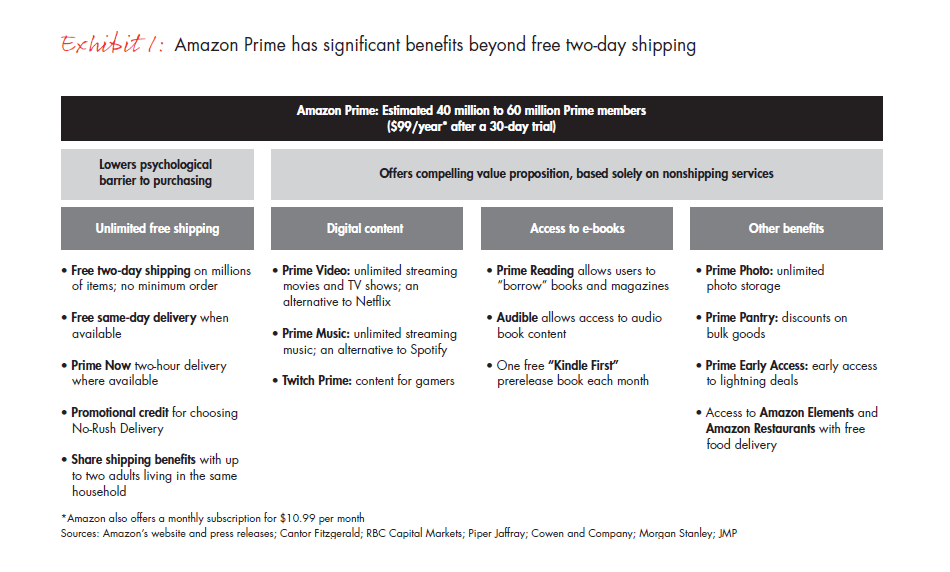
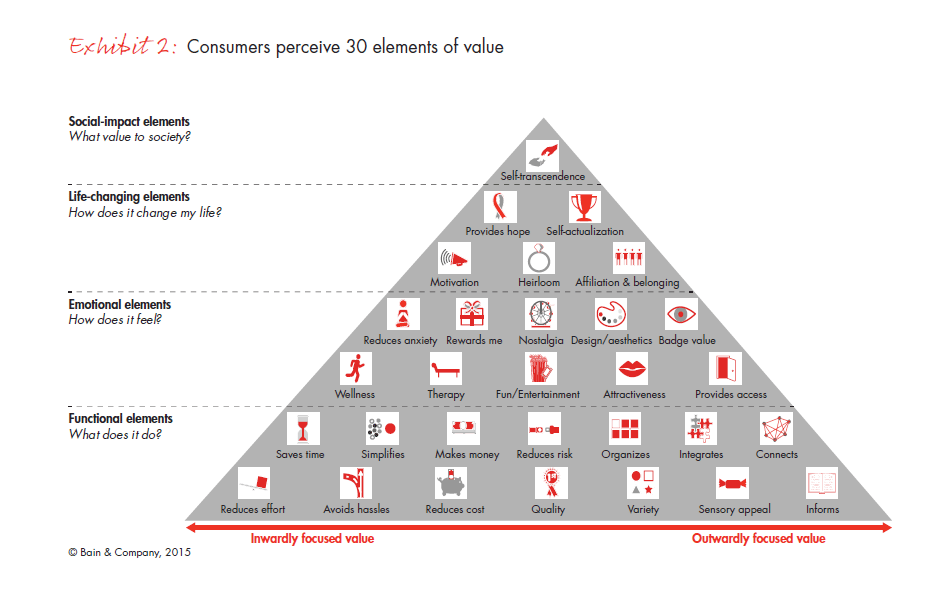
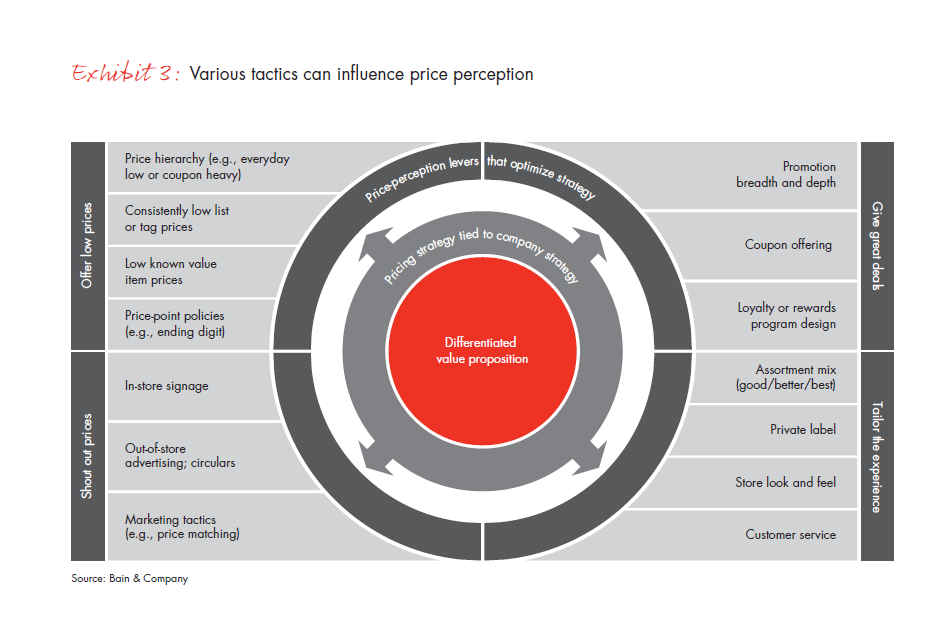
360pi
Retail analytics company 360pi helps top retailers and brands make smarter product and pricing decisions with real-time insight about who is selling what, where, when and for how much. This intelligence helps its clients offer the right products at the right price and time. For more information, visit 360pi.com.
Research Now
Research Now Group, Inc., is a global leader in digital data collection to power analytics and insights. It enables data-driven decision making for its 3,700 market research, consulting, media and corporate clients by providing access to millions of business professionals and consumers. The company has provided proprietary, research-only online panel sample since 2001 and currently operates in over 40 countries from more than 20 offices around the globe with locations in the Americas, Europe, the Middle East and Asia-Pacific. For more information, visit www.researchnow.com.
1The Net Promoter Score® is derived by asking consumers, “On a scale of zero to 10, how likely would you be to recommend this company (or this product) to friends and colleagues?” Ratings of 9 or 10 indicate promoters; 7 and 8, passives; and zero through 6, detractors. The score is simply the percentage of promoters minus the percentage of detractors. Net Promoter®, Net Promoter System®, Net Promoter Score® and NPS® are registered trademarks of Bain & Company, Inc., Fred Reichheld and Satmetrix Systems, Inc.
Bain’s BothBrain® Innovation approach utilizes both the creative and the analytic talents within organizations to innovate across the full customer experience.
Digical® and BothBrain® are registered trademarks of Bain & Company, Inc.









